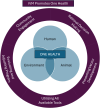One Health, many approaches: integrated vector management strategies support One Health goals
- PMID: 40530168
- PMCID: PMC12171957
- DOI: 10.3389/finsc.2025.1549348
One Health, many approaches: integrated vector management strategies support One Health goals
Abstract
Integrated pest management (IPM) laid the foundation for integrated vector management (IVM) by introducing strategies that prioritize prevention over intervention and the use of diverse management and control tools for arthropod vectors. Both approaches focus on reducing chemical reliance for management of targeted organisms by employing data-driven decisions and incorporating the use of additional non-chemical based management tactics. While IPM and IVM differ in their specific applications and management contexts, many of their fundamental principles remain the same. By diversifying prevention and control options, these management practices support healthier environments, animals, and populace, the three spheres of the One Health paradigm. One Health principles support and highlight the connections between animal, human, and environmental health and how these spheres influence one another. However, the connections and overlapping goals between IVM and One Health are infrequently discussed in tandem. This review will examine the numerous and varied methods of IVM for reducing global disease burden, detail the benefits of using IVM to achieve One Health goals, as well as benefits and considerations to incorporating a One Health lens with IVM.
Keywords: One Health; integrated vector management; pest management; vector control; vector-borne disease.
Copyright © 2025 Tiffin, Gordon and Poh.
Conflict of interest statement
Author JG was employed by the company Bug Lessons Consulting LLC. The remaining authors declare that the research was conducted in the absence of any commercial or financial relationships that could be construed as a potential conflict of interest.
Figures


Similar articles
-
Surveillance for Violent Deaths - National Violent Death Reporting System, 50 States, the District of Columbia, and Puerto Rico, 2022.MMWR Surveill Summ. 2025 Jun 12;74(5):1-42. doi: 10.15585/mmwr.ss7405a1. MMWR Surveill Summ. 2025. PMID: 40493548 Free PMC article.
-
Introducing the dataset for measuring centrality for sustainability-A case study of Pecinci municipality, Serbia.Data Brief. 2025 May 27;61:111714. doi: 10.1016/j.dib.2025.111714. eCollection 2025 Aug. Data Brief. 2025. PMID: 40534919 Free PMC article.
-
Assessing the comparative effects of interventions in COPD: a tutorial on network meta-analysis for clinicians.Respir Res. 2024 Dec 21;25(1):438. doi: 10.1186/s12931-024-03056-x. Respir Res. 2024. PMID: 39709425 Free PMC article. Review.
-
Return to Running After Achilles Tendon Repair: How Do US Navy Service Members' Physical Readiness Tests Change After Undergoing an Achilles Tendon Repair?Clin Orthop Relat Res. 2025 Jun 18. doi: 10.1097/CORR.0000000000003590. Online ahead of print. Clin Orthop Relat Res. 2025. PMID: 40536551
-
Global Delphi consensus on treatment goals for generalized pustular psoriasis.Br J Dermatol. 2025 Mar 18;192(4):706-716. doi: 10.1093/bjd/ljae491. Br J Dermatol. 2025. PMID: 39844356
References
-
- Machalaba CC, Loh EH, Daszak P, Karesh WB. Emerging Diseases from Animals, in: State of the World 2015: Confronting Hidden Threats to Sustainability. Washington, DC: Island Press/Center for Resource Economics; (2015) p. 105–16. doi: 10.5822/978-1-61091-611-0_8 - DOI
-
- Food and Agriculture Organization of the United Nations . Guidelines: Resistance management and integrated parasite control in ruminants. Rome, Italy: Animal Production and Health Division Agriculture Department; (2004).
Publication types
LinkOut - more resources
Full Text Sources

